by Marion Patterson | Mar 23, 2023 | (Sub)Urban Homesteading, Energy Efficiency, Home Improvements
Are battery-powered chainsaws worth the money?
We decided to find out. *
Gas chainsaws have been around for decades. Rich wondered if newer electric battery-powered chainsaws would be as functional and easier to use. So, he acquired a Milwaukee saw with a 16-inch bar and put it to the test alongside his trusty Stihl gas model.
Back in the mid-1970s Rich worked in Idaho felling Douglas Fir and Ponderosa Pine trees. He used a heavy noisy gas fueled chainsaw that was amazingly powerful as it chewed through thick trunks. Years later he bought a Stihl gas-powered saw used to cut the four or five cords of wood we burn each winter for heat. It’s a well-built powerful saw.
A few days after the new battery saw arrived, we heard a crack/boom as a huge oak crashed down across one of our backyard trails. Rich guided the new saw as it sliced through the log, and emerged smiling. “It’s amazing,” he said.
After further use he developed this chart of the pros and cons of the battery vs the gas saw:
Gas: Pro – Plenty of Power, No need to recharge batteries, Longer bar
Gas: Con Noisy and heavy, Must mix/carry/store gas, Must replace gas & air filters, Engine stalls, Pull cord start hard on the shoulder.
Battery: Pro – Plenty of Power, Relatively quiet, Less maintenance, Fairly lightweight, Trigger start, No need to idle, Easy start
Battery: Con – Need a nearby electric outlet to recharge the battery, Shorter bar than a gas saw
Bottom Line. Which One to Buy
Rich has both a gas and electric battery saw. Both are well-made by reliable companies. So, if he didn’t own a saw and needed to cut up trees fallen in the yard which type would he buy?
“I’d buy a quality battery saw. They are easy to use, cut fast, and there’s no need to buy, mix, and store gas. They are also quiet, but I still use hearing protection when using one. There are major advantages of battery over gas. One is
eliminating the need to pull a cord to start it. You just pull the trigger. The second is especially helpful when cutting a fallen tree with branches. Often this requires cutting, then putting the saw aside to clear away the cut branches, then using the saw to cut more. Gas saws don’t idle well and often stall, requiring another pull on the starter cord. Also, when idling gas saws burn fuel and spew emissions. Battery saws excel when there’s a need to cut and then move wood.”
Battery-powered chainsaws use lots of electricity. He was able to cut 13 15-inch diameter black oak logs on one charge with a 12-amp hour battery. The saw will function well on batteries with lower amp hour ratings, but they will run down sooner. He suggests having two 12-amp hour batteries and notes that being close to a power source for recharging is useful. It is likely that the cost of recharging a battery is lower than the comparable amount of energy in gasoline but it’s difficult to make a comparison.
Safety
Operating any chainsaw must be done with safety in mind. Here is Rich’s list of safety precautions to keep in mind:
- Get saw training. In-person training is best but YouTube videos help.
- Always wear protective equipment that includes saw chaps, leather gloves, hearing, ear, head and eye protection, and sturdy leather boots.
- Saw with a partner nearby and carry a cell phone in case of emergency.
- Keep the chain sharp. YouTube videos show how to sharpen.
- Rest before you get tired.
- Be alert. Save the cold beer for after you are done.
-
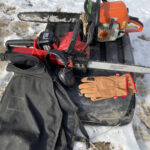
-
Gas and battery saws with protective equipment.
-
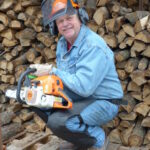
-
Rich in protective equipment.
-
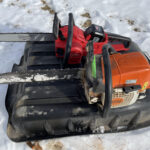
-
Quality gas and electric saws.
Final Thoughts
Rich has years of experience using many power tools and shares these thoughts:
Quality pays. “I buy quality tools, even if I have to wait until I save up enough money. Most of my tools are Milwaukee brand. The same batteries that power my chainsaw also power my drills, fans, vacuum cleaner, lights, inflater, hedge trimmer and other saw types. Many quality brands are on the market. They have their own specific type of battery that won’t work with other brands. So, I consistently buy the same brand for convenience.
Yard Tool’s Future
At Winding Pathways, we have replaced our gas lawn mower, snowblower, and now chainsaw with battery-powered equivalents. They are excellent and come with benefits over gas models. We see gas yard tools moving toward obsolescence and battery-powered ones becoming ever more versatile.
Disclosure*
Rich has purchased, at retail cost, most of his power tools. Milwaukee has provided others for testing.
by Winding Pathways | Feb 5, 2015 | (Sub)Urban Homesteading, Preparedness
Every once in a while every homeowners needs to cut wood. Hedges overgrow. Branches break and land in the driveway. Trees need pruning. And sometimes firewood must be cut.
There’s been a recent evolution in saws that helps homeowners manage trees and shrubs. Muscle powered types have been around for years. Gasoline chainsaws appeared in the 1950s and keep improving in ease of use, safety and efficiency. Recently, cordless electric saws entered the market. Each type saw has strong benefits and some drawbacks.
USING MUSCLES
If you just need to cut a few fallen branches, don’t buy an inexpensive chainsaw at a big box store. For small jobs a sharp muscle powered saw is often best.
Here are some advantages:
- Much less expensive than a chainsaw.
- No need for gasoline. Human power works and yields exercise!
- No noisy motor to barrage the air or break down.
- Need little storage space and last for years.
- Blade can be re-sharpened or replaced on a bow saw.
Here is one disadvantage:
- Although generally safe, they can inflict a nasty cut.
Two types of commonly available muscle powered saws are useful in the yard.
Bow saws look alittle like an old fashioned bow without the arrow. A tubular steel frame forms the bow and a replaceable blade is the “string”. They come in sizes based on blade length from 12” to 36”. Medium sized ones are best for most backyard chores. Bow saws are ideal for cutting fallen branches into firewood. A sharp one slices through a three inch diameter branch with ease. The downside of bow saws is their somewhat ragged cut. That’s hardly a problem with firewood, but a clean cut is important when pruning living trees. That’s where a pruning saw shines.
Pruning Saws look somewhat like carpenter’s hand saws but normally have larger teeth and sometimes a curved blade. They are designed to cut cleanly with little tearing so the tree heals easily.
Muscle powered saws are efficient IF THEY ARE WELL DESIGNED AND SHARP. Buy a quality saw and keep it sharp. Store it in a in a dry place where it won’t rust. For long term storage, for example over winter, put a light coating of oil on the blade to reduce odds of rusting.
A SHORT PRIMER ON CHAINSAWS
Chainsaws come into their own when lots of wood needs to be cut, especially if it is of large diameter.
Early model saws from the 1970s and earlier were heavy, noisy and vibrated severally. But, newer ones are easier and more comfortable to use. They also incorporate safety features lacking on old timers.
A chainsaw’s cutting teeth zip along at about 60 miles per hour. Every tooth passes the same spot on the bar about 20 times a second! When properly sharpened they roar through wood but can do instant and major damage to human flesh.
Using a chain saw properly and safety takes skill. Even the most experienced operators wear safety equipment and always remember to work safely. Too many people who have never used a chainsaw buy one, rev it up and begin cutting without getting proper training or using proper safety equipment. BE SAFE!
Chainsaws range from small lightweight inexpensive homeowner models to heavy powerful logging machines. A motor powers a sprocket that drives a tooth studded chain round a “bar”. Most bars range from 14 to 20 inches. Saws squirt oil from a small tank into the chain to reduce friction and heat.
Buying A Chain Saw: Most chainsaws sold by big box stores are, essentially, throw away models. They are inexpensive and fine for small infrequent use, but for long term durability, ease of use and repair, invest in a quality saw. Before you buy ask if the store has a repair department. If not buy your saw somewhere else. Quality saws are sold at specialty stores that also sell safety equipment, spare parts and maintenance supplies. Chances are the sales person is a seasoned saw operator who will coach a buyer on operating the saw, safety and maintenance.
Remember those cutting teeth go 60 miles an hour! BE SAFE. Always wear ear, head and eye protection, leather gloves, leather boots and saw chaps. Safety equipment can’t prevent all accidents but it can help reduce injury should something go wrong. About 40% of chainsaw injuries are to the legs. Chaps are like an apron made of materials designed to slow or stop a chain should it impact a leg.
Saws are noisy and can permanently damage hearing. Muffs that fit over the ears or small plugs that fit inside ears are essential. Some people choose to wear both types of hearing protection at the same time for ultimate noise reduction. Safety glasses help protect eyes from debris that sometimes flies off the saw.
Head injuries account for about half of chainsaw deaths! Wearing a stout hard hat reduces odds of a head injury. Some operators use a hard hat that has a face shield and ear muffs attached.
ALWAYS BE SAFE. Some other safety tips include:
- Have a first aid kit and cell phone handy.
- Regularly inspect safety equipment. Replace anything that seems faulty.
- Keep the saw sharp and well maintained
- Take breaks to ward off fatigue.
- Saw when others know you are sawing and can help if needed.
- Check the chain brake before starting the saw. If it is in the forward position the chain should be locked and not move.
Chainsaws are potentially dangerous. Using one efficiently and safely is a high skill that comes with a learning curve. In some areas chain saw classes are available. Websites, books and You Tube videos help a novice learn saw techniques and safety. Watch and read before starting the saw! Videos and books can also help a novice learn how to properly sharpen their saw’s teeth.
Probably the best way to learn saw operation and maintenance is to find an experienced mentor and spend time working with him or her.
ALWAYS BE SAFE. Many scenarios can lead to chain saw accidents but two are too common.
One is haste. It’s tempting to fire up the saw without donning safety equipment and hurriedly work when there’s only a branch or two to cut. Always don safety equipment and take your time. The second scenario is fatigue. Wood cutting is hard work and wise experienced loggers in superb physical condition recognize when they are getting tired and take a break.
Employees of the U.S. Forest Service often use chain saws. A standard greeting between two of their staff isn’t to say, “Hi” or “goodbye”. They say “BE SAFE”!
One gorgeous summer morning high in Idaho’s mountains I witnessed a serious chain saw accident that could have been completely prevented. Our crew was all seasoned operators and typically we took a mid-morning break to rest and sharpen saws. We were on an old logging road and one of our crew was sharpening his saw. We heard a yell and looked over to see him clutching his hand. Blood curled down his forearm from a deep cut on his palm. A crew member applied pressure, put on several layers of gauze, and taped it tightly. I was appointed to drive him to the nearest hospital, which was an hour distant. The doctor sewed the cut shut.The cut happened when his hand slipped while filing a tooth. The saw was not even running. Had he worn leather gloves there might have been a cut glove but an uninjured hand.
LESSON: Wear leather gloves, even when sharpening a saw. |
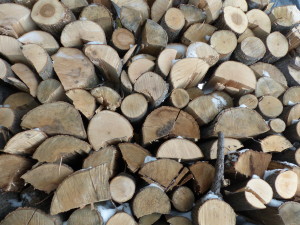
Wood carefully cut, split and stacked.
BATTERY AND ELECTRIC CHAIN SAWS
In recent years many new types of electric saws have entered the market. Most corded models are designed for light work, not cutting many cords of firewood. They are lightweight, generally less expensive than gas saws, quiet, cut well and need no gas, although they require oil to lubricate the chain. Their downside is the tether, so they are only useful near an electric outlet.
Cordless electric chainsaws saws are powered by a lithium ion battery. They are amazing machines that merge many of the benefits of gas and corded saws. Stihl and other companies sell a wide range of yard maintenance tools that operate on the same battery as the chain saw. This allows for flexibility.
Quality battery operated saws allow plenty of cutting on one charge, but for long time use it’s wise to have two batteries. When one is in use the other is on the charger. Stihl claims that a fully charged battery gives about 35 minutes of trigger time and takes about 25 minutes to recharge.
BE SAFE: SAFETY PRECAUTIONS FOR GAS SAWS APPLY TO ELECTRIC AND BATTERY MODELS
WINDING PATHWAYS AND SAWS
Winding Pathways co-owner Rich Patterson began using chain saws in 1974 when he logged on Idaho’s Boise National Forest. He had the good fortune to be mentored by several experienced saw operators. For four months he cut down huge trees and bucked them into lengths. Since then he’s used dozens of saws for firewood cutting, tidying up his yard and for removing fallen trees from trails and ecological restoration at two nature centers where he served as executive director. Over the years he has taught many people safe and effective saw use and he’s purchased and used chainsaws of many brands and configurations.
STIHL COMPANY PROFILE
by Rich Patterson
About a dozen years ago I used my first Stihl chainsaw and now that is the only brand I use. My current Stihl 290 is about eight years old and has cut over 60 cords of firewood. It’s
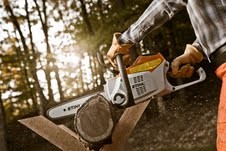
Safety gear and quality tools make for safe cutting of wood.
reliable, solid, easy to maintain and fixable. Only one time did I have a minor problem with it. At the store where I bought it, the staff looked it over the saw and had it running smoothly in just a few minutes.
The Stihl Company was founded by inventor Andreas Stihl in 1926 in Germany. It came came to the United States in 1974 and today makes a wide range of handy tools for managing trees, turf and other functions. Most are made in Virginia Beach, Virginia, with many components made in the United States.
Stihl’s website, www.stihlusa.com, is an amazing resource. It includes videos and articles that help teach how to start, safely use, sharpen and maintain saws and other equipment. There’s even a link to help identify tree species. The site offers excellent education and technical information about equipment.
The Internet is an outstanding resource for information on the use and care of equipment and wood characteristics among other topics. Just remember that Internet videos and blogs are only as good as the person who or company that produced them.
Be Safe and happy cutting!
by Winding Pathways | Mar 27, 2025 | (Sub)Urban Homesteading, Home Improvements
- Disclaimer: Both Milwaukee and Ego have provided us with tools to test, however, we purchased most of our tools at retail cost, including Milwaukee and Ego brands.
There it was, printed clearly in the owner’s manual. Clean the tool.
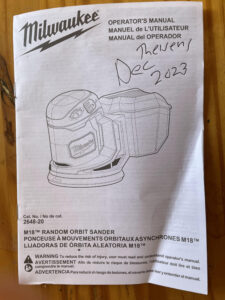
Review the owners manual before operating a tool.
I’d just bought a Milwaukee Brand Random Orbit Sander. Even before handling it I fished the owner’s manual out of the box, wrote the date of purchase and location I bought it on the manual, and leafed through it. Included were clear instructions on the importance of cleaning the backing pad.
Test and Clean
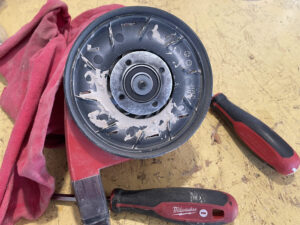
Wood dust on bottom of sander.
After testing my new sander, I unfastened the backing pad to find a surprising amount of wood dust packed in crevices. A bit of work with a brush and rag, combined with brisk blowing, swept the debris away, making the sander ready for its next use.
“It’s important to keep all tools clean, lubricated and well maintained. Saws, grinders, and sanders tend to create much debris that can lodge inside them, said Pete Carlson, my tool mentor and and an employee of Milwaukee Tools. “Keeping them clean helps the tool run efficiently, and safely,” he added.
Habit
I think I’m unusual. Right after buying any mechanical device, whether it is a new refrigerator, fishing reel, or tool, I write the date of acquisition on the owner’s manual and include where I bought it. Then I leaf through the instructions and place them in a permanent file for future reference. I also use a Sharpie pen and write my name and the purchase date on the new item. Above all, I immediately clean the tool when done using it.
Read the Manual
Reading the manual helps me learn the capabilities of a tool or reel that I didn’t know. Instructions also clearly detail maintenance needs and sometimes include troubleshooting and repair information if there’s a problem.
At Winding Pathways, we use chainsaws, trimmers, mowers, and snowblowers for outdoor land management and a diversity of carpentry tools for home maintenance. Years ago, I bought a starter kit of battery-powered Milwaukee brand tools and have built on the system often. I love ‘em for their efficiency, ease of use, and safety.
Lesson from the Army
Back in Army trainee days my squad’s crusty drill sergeant wouldn’t let us go to chow after a tiring day until we’d thoroughly cleaned our rifles. We were usually starved but knew the sergeant was right. It became a habit. Now, after a chainsaw session I may be tired and hungry but the priority is cleaning and sharpening the saw.
Clean the tool.
Rich’s Tool Tips
- Buy quality tools, but before using one read the owner’s manual.
- Wear protective gear. Usually, that means hearing and eye protection, sturdy gloves and shoes, and, when chainsawing chaps.
- Clean every tool after use.
- Keep cutting tools sharp, lubricated, and well-maintained.
Respecting Tools
Tools are amazing. They make the most difficult chore easier and faster. But they should be treated with care and respect and used safely.
Sourcing Tools
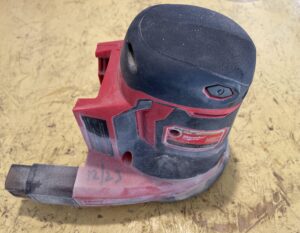
Side view with date of purchase.
Most of our tools are either the Milwaukee or EGO Brand. We like them both and occasionally buy a new tool to run on their battery systems. As we buy new tools or replace old ones, we tend to buy Milwaukee for the quality and convenience of using one battery system. Other companies sell quality tools as well.
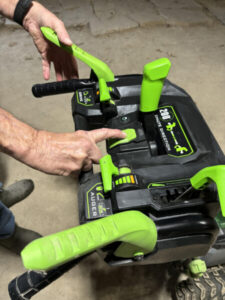
The snowblower starts with a push of a button.
by Winding Pathways | Apr 11, 2024 | (Sub)Urban Homesteading, Home Improvements
A rarely used handy tool made our lives easier after we found a box on our porch. It contained a remote weather station our two grown children chipped in to buy it for us.
Many parts needed to be assembled. That would have been difficult had we not been “tool proactive”. The weather station had a small door that covered a battery compartment. Opening it required using a tiny mini screwdriver.
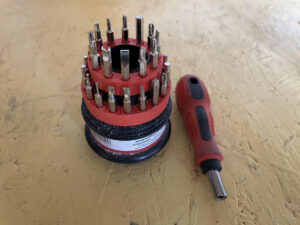
Screwdriver set with mini-bit-heads.
Rich occasionally buys somewhat unusual tools to help with special household or yard needs. One was a lifesaver for putting together the weather station. It was a mini screwdriver kit with about 20-bit heads made for jobs too small for normal tools. It helped us easily and quickly assemble the weather station.
How We Organize Tools at Winding Pathways
House Tools. Easy to Grab
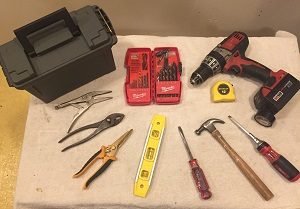
We find Milwaukee Tools, Stanley, and Vice Grips three excellent brands to have around.
We keep a toolbox in the house for quick needs. It includes Phillips and slot screwdrivers, pliers, Marion’s mother’s mini hammer, an adjustable wrench, measuring tape, a small “torpedo” level, a scraper, and a short coil of wire. The house toolbox is close at hand and enables us to fix most problems inside the house.
More Serious Diverse Tools.
Rich keeps major project tools on a pegboard in our cabin. These include hammers, squares, hand saws, many types of screwdrivers and pliers, files, chisels, hearing protectors, and clamps. On a nearby shelf is a toolbox holding rarely used tools. They’re specialty ones used when encountering unusual fixit or carpentry needs. These include odd drill bit sizes, unusually shaped files, contour gauges, and even a set of carving tools. Although not often used, once in a while they make life easy when a project has an odd need.
Battery Powered Power Tools
Although muscle-powered tools are perfect for small jobs, power tools make many projects shorter and easier. Rich keeps a drill, driver, jigsaw, circular saw, and sanders in a cabin cabinet. Over several years, battery-powered, or cordless, tools have come on the market. They are gradually replacing corded counterparts. Several companies make them, and each has its own battery system. It’s best to stay with one brand, so all tools operate on the same style battery. Rich began building his tool system with the Milwaukee brand years ago and occasionally buys a new power tool to add to the system. His Milwaukee batteries power carpentry tools as well as trimmers and chainsaws for outside use.
-
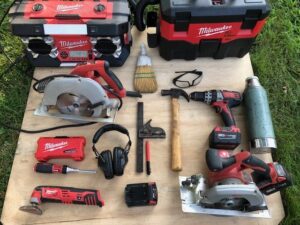
-
We switched to cordless tools gradually.
-
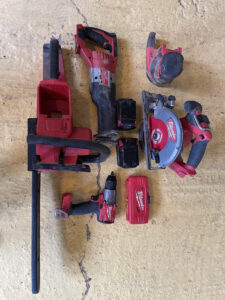
-
Stick with one brand of tools.
Tool Tips
- Buy quality tools. There’s a lot of junk on the market. Quality tools of any configuration are easier to use and last longer than cheap ones.
- Frequent garage sales. Years ago, most screwdrivers, wrenches, pliers, chisels, and clamps were high quality and made in the United States. These muscle-powered tools don’t go obsolete and often can be purchased for just a buck or two, even if they’re 40 or 50 years old. In contrast, many power tools sold at garage sales are equally old and inexpensive but often are much less effective than newer counterparts. Most are corded. They may be fine for occasional jobs but buying newer power tools is usually worth the money.
-
-

-
One way to measure a truck bed.
-
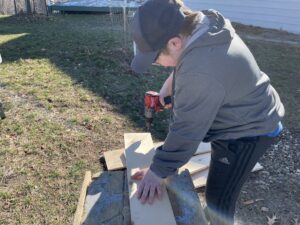
-
Learning to safely use tools.
Summary
Fixing and building items around the house can be a chore or a source of satisfying pride. Often, it’s impossible to find someone to hire for small fixit jobs, and hiring anyone to do a project is costly. Doing it yourself brings cost savings and satisfaction. Don’t know how? Check your friend, YouTube. Chances are good there are many posts showing how to fix or build it.
by Winding Pathways | Jun 23, 2022 | (Sub)Urban Homesteading, Energy Efficiency, Home Improvements
Want to buy gas for a buck a gallon? Well, you can but you won’t find it at a service station. It’s available at the electrical outlet in the garage or shop.
Battery-Operated Tools
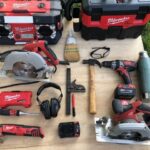
We switched to cordless tools gradually.
Nearly ten years ago we switched from plug-in carpentry tools to battery (cordless) equivalents. We loved them for their power, effectiveness, quietness, and ease of use. So, when battery-powered yard tools came on the market we gradually switched.
In 2018 we ditched our gas lawn mower and replaced it with a battery unit….with concern. Would it have the power of our gas machine to chew through tall grass and weeds? Would it have enough battery storage to mow the entire lawn?
Mowers
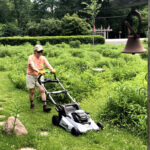
Maintaining the labyrinth is work. And a way to connect.
We quickly learned our concerns were false. The mower chewed through tough prairie grass and buzzed off our traditional lawn with ease. We liked it so much we bought another one so we could both mow simultaneously. Then came a trimmer, chain saw, and snow blower that all run on the same battery system. We love them all and believe gas-powered equivalents are on the road to obsolescence.
How about operating costs? Experts at our utility, Alliant Energy, told us that one gallon of gasoline has the energy equivalent of 33.7-kilowatt hours of electricity. As of mid-June 2022, gasoline average cost pushed to $4.60+ a gallon in Cedar Rapids. 33.7 kWh of electricity costs, on average in Iowa, $1.03.
Operating our battery tools costs a quarter of our old gas equivalents.
Benefits of Electric Tools

Comparison of a gas mower and the EGO cordless lawnmower.
But, there’s more than cost savings with battery-operated tools. Here are aspects we love about our mowers, trimmers, saws, and snowblowers:
- No rope to pull to start the machine. We save the shoulders! Just press a switch.
- No filters or oil to change.
- No need to buy and store gasoline. Fuel is always at hand at the electrical outlet.
- No fumes to breathe while operating.
- No noisy internal gas explosions. Battery electric machines are quiet.
- Easy to fold and store.
So, what are the downsides of battery-operated tools? We had to think about that and came up with only one thing. They may cost more than gas machines, and batteries are expensive. However, the batteries last a long time, perhaps as many as 2000 charge/discharge cycles.
The cost of electricity varies from place to place. Utilities print the kilowatt-hour charge on monthly bills. To calculate the cost of 33.7 kWh of electricity multiply that number by your per kWh cost and add in any taxes or service fees. Almost certainly it will cost less to charge a battery than to buy gas.
Have a cranky old gas mower? We suggest replacing it with a battery-powered equivalent.


















